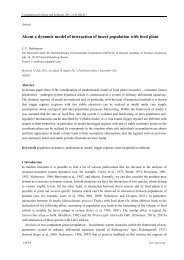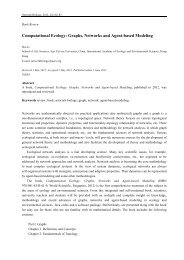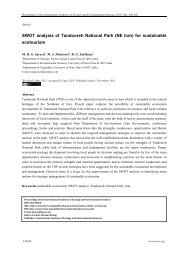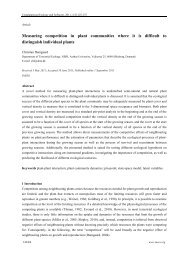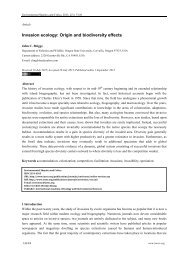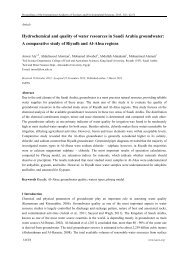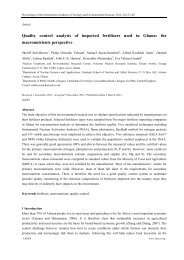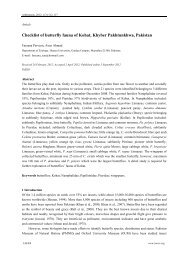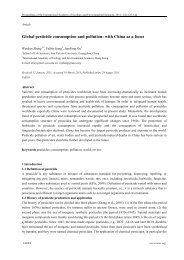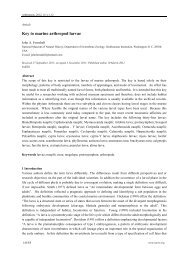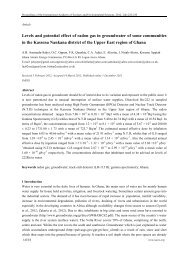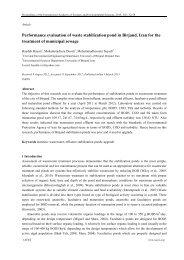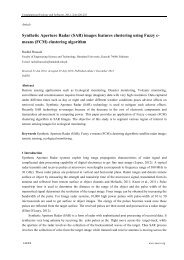Diversity and habitat preference of brachyuran crabs in Gulf of Kutch ...
Diversity and habitat preference of brachyuran crabs in Gulf of Kutch ...
Diversity and habitat preference of brachyuran crabs in Gulf of Kutch ...
Create successful ePaper yourself
Turn your PDF publications into a flip-book with our unique Google optimized e-Paper software.
14<br />
Arthropods, 2012, 1(1):13-23<br />
make 80% faunal biomass (Golly et al., 1962) <strong>and</strong> their density can reach up to 80-90 <strong>in</strong>dividuals per m 2<br />
(Mac<strong>in</strong>tosh, 1984).<br />
<strong>Gulf</strong> <strong>of</strong> <strong>Kutch</strong>, an <strong>in</strong>dent to ma<strong>in</strong>l<strong>and</strong> <strong>of</strong> Gujarat is fourth major coral reefs areas <strong>of</strong> India. This area is<br />
geographically isolated from other reef areas <strong>of</strong> India; still it shows great varieties <strong>of</strong> mar<strong>in</strong>e <strong>habitat</strong>s like coral<br />
reefs, mangroves, rocky <strong>in</strong>tertidal zone <strong>and</strong> sea grass beds. The area is extensively explored by researchers as<br />
far as Scleracitnian <strong>and</strong> molluscs groups are concerned. Total 45 different species <strong>of</strong> hard corals (Dixit et al.,<br />
2010; Pillai <strong>and</strong> Patel, 1988) <strong>and</strong> 188 species <strong>of</strong> mollusc species were recorded <strong>in</strong> this area (Apte, 1998). Major<br />
mangrove forest cover <strong>of</strong> the state lies <strong>in</strong> the area <strong>and</strong> the mangrove ecology is well studied with reference to<br />
floral diversity but faunal component is least studied (P<strong>and</strong>ey <strong>and</strong> P<strong>and</strong>ey, 2010). Except few studies on<br />
mar<strong>in</strong>e fauna <strong>of</strong> the then Mumbai state (Chhapgar, 1957) no particular studies on <strong>brachyuran</strong> crab fauna have<br />
been done. So to generate the basel<strong>in</strong>e picture <strong>of</strong> <strong>brachyuran</strong> crab diversity <strong>of</strong> <strong>Gulf</strong> <strong>of</strong> <strong>Kutch</strong>, the present study<br />
was carried out at eight different sites <strong>of</strong> <strong>Gulf</strong> <strong>of</strong> <strong>Kutch</strong>. The ma<strong>in</strong> aim <strong>of</strong> the study is to generate the<br />
<strong>in</strong>formation on <strong>brachyuran</strong> crab diversity <strong>and</strong> their <strong>habitat</strong> <strong>preference</strong> <strong>in</strong> selected <strong>habitat</strong>s <strong>of</strong> <strong>Gulf</strong> <strong>of</strong> <strong>Kutch</strong>.<br />
However, the area <strong>of</strong> Mar<strong>in</strong>e National Park <strong>and</strong> Sanctuary was not <strong>in</strong>cluded <strong>in</strong> the present study.<br />
2 Materials <strong>and</strong> Methods<br />
2.1 Study sites<br />
<strong>Gulf</strong> <strong>of</strong> <strong>Kutch</strong> is the western proximity <strong>of</strong> Gujarat state <strong>and</strong> as stated earlier, it harbors huge variety <strong>of</strong> mar<strong>in</strong>e<br />
fauna. For the present study few locations <strong>of</strong> <strong>Gulf</strong> <strong>of</strong> <strong>Kutch</strong> (except Mar<strong>in</strong>e National Park <strong>and</strong> Sanctuary area)<br />
were selected (Fig. 1). The study sites were not with<strong>in</strong> the Mar<strong>in</strong>e national Park, however, consider<strong>in</strong>g the<br />
legislative regulations collection, preservation or museum deposition <strong>of</strong> any specimen was not done.<br />
1<br />
2<br />
3<br />
4<br />
5<br />
6<br />
16<br />
15<br />
14<br />
13<br />
8<br />
10<br />
9<br />
12 11<br />
7<br />
Fig. 1 Distribution <strong>of</strong> sampl<strong>in</strong>g sites <strong>in</strong> study area<br />
The crab diversity was studied at eight different stations (Table 1). Selection <strong>of</strong> the stations was done on<br />
the basis <strong>of</strong> two parameters; one is <strong>habitat</strong> diversity (e.g. mangroves mudflats, open mudflats <strong>and</strong> rocky shores)<br />
<strong>and</strong> second is accessibility <strong>of</strong> the study site. The study area was classified <strong>in</strong> to three ma<strong>in</strong> <strong>habitat</strong> types; among<br />
the mud flats; area near the low tide mark <strong>and</strong> with no vegetation cover was considered as open mudflat, the<br />
mud flat which has mangrove canopy cover is considered as mangrove mudflats <strong>and</strong> the others <strong>in</strong>cluded rocky<br />
shores. Avic<strong>in</strong>ia mar<strong>in</strong>a makes the major canopy cover <strong>of</strong> mangrove mudflats <strong>of</strong> the study area while the<br />
canopy made by Rhizophora mucronata <strong>and</strong> Ceriops tugal were comparatively much sparse. Furthermore, the<br />
IAEES<br />
www.iaees.org



